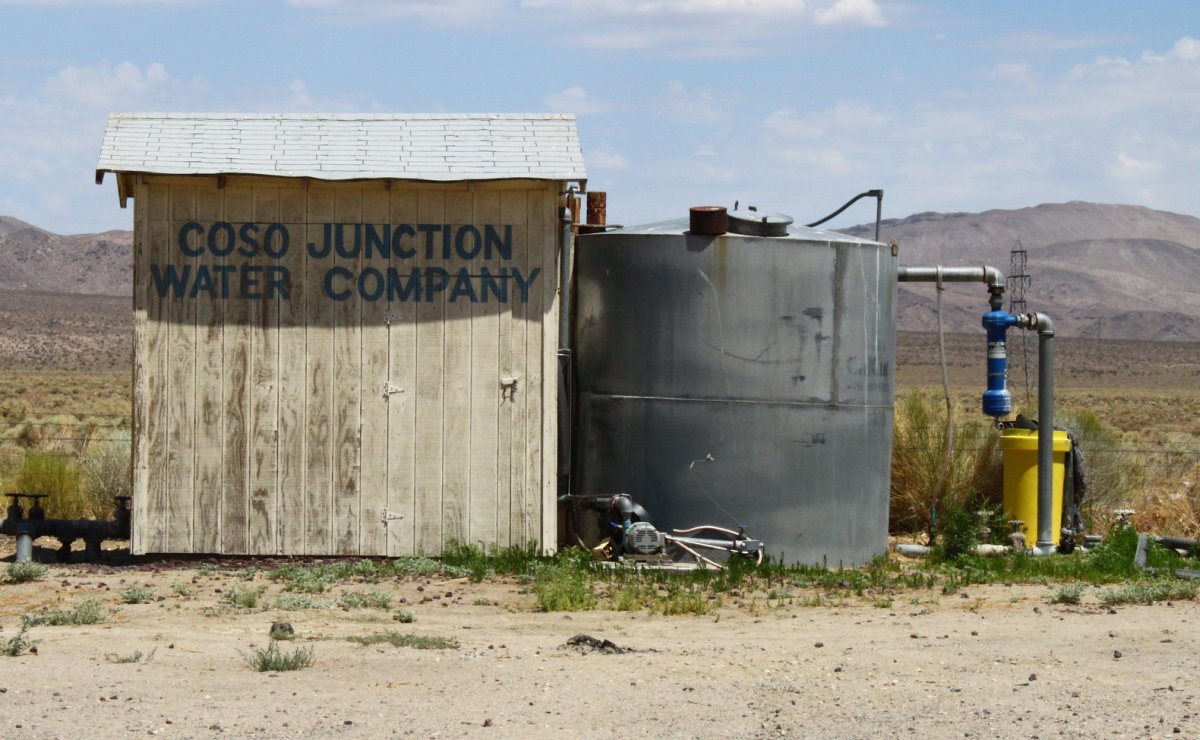
Declining water tables and impacts to groundwater quality can affect a variety of users but tend to hurt small water supply systems and domestic well owners disproportionately, as those wells tend to be typically shallower than irrigation and municipal supply wells.
SGMA requires GSAs to consider all beneficial uses and users of groundwater as they create and implement GSPs, and California law lists domestic use of water as the highest priority of use. Additionally, California became the first state in the nation to legally recognize the human right to water with the adoption of AB 685 that was signed into law by Governor Jerry Brown on September 25, 2012, requiring state agencies to explicitly consider the human right to water in every relevant agency decision and activity.
Writing plans which protect drinking water and ensure the management actions required under the law do not negatively impact groundwater quality will be critical.
Key publications
Domestic Wells and SGMA
[pdf-embedder url=”https://f0b.362.mwp.accessdomain.com/wp-content/uploads/2020/09/Domestic-Well-Users-Brochure-English-Version.pdf”]Report: Groundwater Management and Safe Drinking Water in the San Joaquin Valley
[pdf-embedder url=”https://f0b.362.mwp.accessdomain.com/wp-content/uploads/2020/09/Groundwater-Management-and-Safe-Drinking-Water-in-the-San-Joaquin-Valley-Brief-6-2020.pdf”]SGMA and the Human Right to Water: To what extent do submitted Groundwater Sustainability Plans address drinking water uses and users?
By: Kristin Dobbin, Darcy Bostic, Michael Kuo and Jessica Mendoza
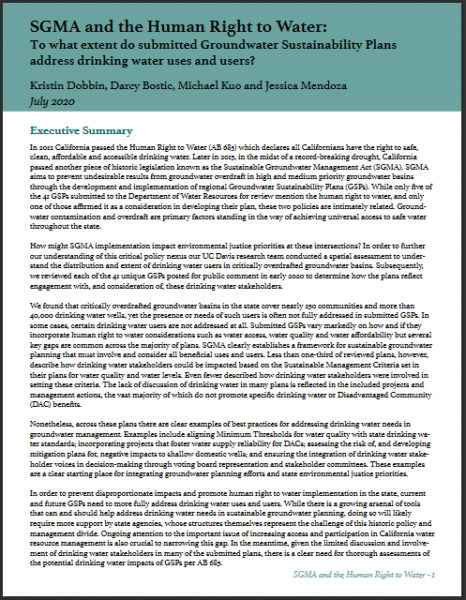 In 2012 California passed the Human Right to Water (AB 685) which declares all Californians have the right to safe, clean, affordable and accessible drinking water. Later in 2015, in the midst of a record-breaking drought, California passed another piece of historic legislation known as the Sustainable Groundwater Management Act (SGMA). SGMA aims to prevent undesirable results from groundwater overdraft in high and medium priority groundwater basins through the development and implementation of regional Groundwater Sustainability Plans (GSPs). While only five of the 41 GSPs submitted to the Department of Water Resources for review mention the human right to water, and only one of those affirmed it as a consideration in developing their plan, these two policies are intimately related.
In 2012 California passed the Human Right to Water (AB 685) which declares all Californians have the right to safe, clean, affordable and accessible drinking water. Later in 2015, in the midst of a record-breaking drought, California passed another piece of historic legislation known as the Sustainable Groundwater Management Act (SGMA). SGMA aims to prevent undesirable results from groundwater overdraft in high and medium priority groundwater basins through the development and implementation of regional Groundwater Sustainability Plans (GSPs). While only five of the 41 GSPs submitted to the Department of Water Resources for review mention the human right to water, and only one of those affirmed it as a consideration in developing their plan, these two policies are intimately related.
Ground-water contamination and overdraft are primary factors standing in the way of achieving universal access to safe water throughout the state. How might SGMA implementation impact environmental justice priorities at these intersections? In order to further our understanding of this critical policy nexus our UC Davis research team conducted a spatial assessment to understand the distribution and extent of drinking water users in critically overdrafted groundwater basins. Subsequently, we reviewed each of the 41 unique GSPs posted for public comment in early 2020 to determine how the plans reflect engagement with, and consideration of, these drinking water stakeholders.
Groundwater Markets: Recommendations to Ensure Drinking Water Protections for Communities
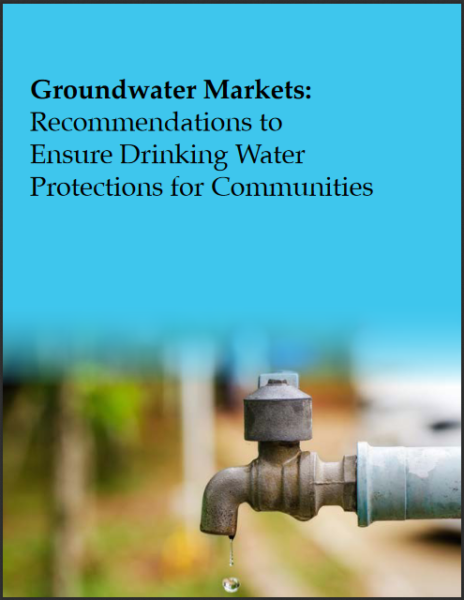 SGMA is likely to result in significant changes in historical pumping patterns through the many management actions and projects that will be implemented over the next 20 and more years. One potential management action and project, and focus of this white paper, is to develop a system to trade groundwater pumping allocations.
SGMA is likely to result in significant changes in historical pumping patterns through the many management actions and projects that will be implemented over the next 20 and more years. One potential management action and project, and focus of this white paper, is to develop a system to trade groundwater pumping allocations.
Though the trading or transfer of surface water is a fairly common practice, trading groundwater is a newer endeavor in California that requires the development of thoughtful frameworks and rules to ensure that all groundwater-dependent communities are protected.
The purpose of this white paper is to:
1. Provide an overview of some of the major elements to consider when developing a well-designed groundwater market.
2. Introduce tools to help community stakeholders engage in the market design and implementation process.
3. Hold decision makers accountable in developing groundwater management strategies that are protective of community needs.
This white paper prioritizes key recommendations for the protection of drinking water sources where groundwater markets are adopted.
Framework for a Drinking Water Well Impact Mitigation Program
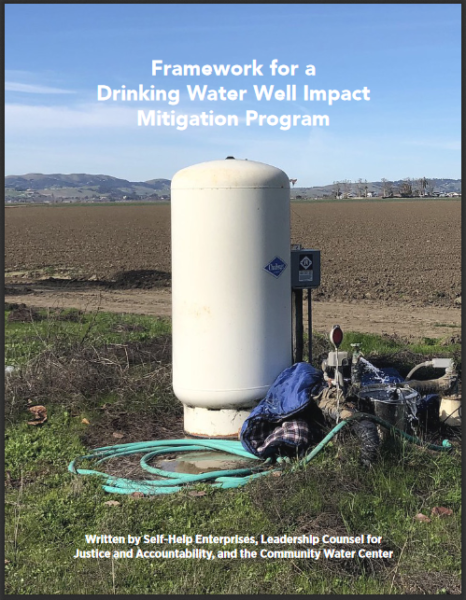 The purpose of this document is to be utilized by GSAs to mitigate, prevent, and address any adverse effects on drinking water wells caused by groundwater pumping volume or location, conjunctive management, or any other forms of active management as part of Groundwater Sustainability Plan (GSP) implementation.
The purpose of this document is to be utilized by GSAs to mitigate, prevent, and address any adverse effects on drinking water wells caused by groundwater pumping volume or location, conjunctive management, or any other forms of active management as part of Groundwater Sustainability Plan (GSP) implementation.
By doing so, GSAs can better achieve the goals of the Sustainable Groundwater Management Act (SGMA), avoid jeopardizing access to safe water in vulnerable communities, and also avoid violating California laws that establish a statewide Human Right to Water and that protect access to safe water.
Adverse effects can include both issues with access to safe drinking water due to increased contamination, as well as issues with sustained access to water due to changes in groundwater levels.
Publicaciones clave en español
Los usuarios de pozos domésticos y la SGMA
[pdf-embedder url=”https://f0b.362.mwp.accessdomain.com/wp-content/uploads/2020/09/Domestic_Well_Users_Brochure_-_Spanish_Version.pdf”]SGMA y el Derecho Humano al Agua: ¿Como se trata los usos y usuarios de agua potable en los Planes de Manejo Sostenible de Agua Subterránea (GSPs) sometidos?
Kristin Dobbin, Darcy Bostic, Michael Kuo y Jessica Mendoza
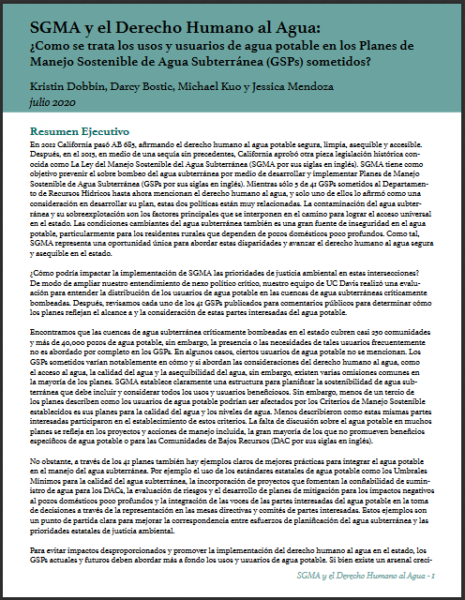 En 2012 California pasó AB 685, afirmando el derecho humano al agua potable segura, limpia, asequible y accesible. Después, en el 2015, en medio de una sequía sin precedentes, California aprobó otra pieza legislación histórica con-ocida como La Ley del Manejo Sostenible del Agua Subterránea (SGMA por sus siglas en inglés). SGMA tiene como objetivo prevenir el sobre bombeo del agua subterránea por medio de desarrollar y implementar Planes de Manejo Sostenible de Agua Subterránea (GSPs por sus siglas en inglés). Mientras sólo 5 de 41 GSPs sometidos al Departamen-to de Recursos Hídricos hasta ahora mencionan el derecho humano al agua, y solo uno de ellos lo afirmó como una consideración en desarrollar su plan, estas dos políticas están muy relacionadas. La contaminación del agua subter-ránea y su sobreexplotación son los factores principales que se interponen en el camino para lograr el acceso universal en el estado. Las condiciones cambiantes del agua subterránea también es una gran fuente de inseguridad en el agua potable, particularmente para los residentes rurales que dependen de pozos domésticos poco profundos. Como tal, SGMA representa una oportunidad única para abordar estas disparidades y avanzar el derecho humano al agua segura y asequible en el estado.
En 2012 California pasó AB 685, afirmando el derecho humano al agua potable segura, limpia, asequible y accesible. Después, en el 2015, en medio de una sequía sin precedentes, California aprobó otra pieza legislación histórica con-ocida como La Ley del Manejo Sostenible del Agua Subterránea (SGMA por sus siglas en inglés). SGMA tiene como objetivo prevenir el sobre bombeo del agua subterránea por medio de desarrollar y implementar Planes de Manejo Sostenible de Agua Subterránea (GSPs por sus siglas en inglés). Mientras sólo 5 de 41 GSPs sometidos al Departamen-to de Recursos Hídricos hasta ahora mencionan el derecho humano al agua, y solo uno de ellos lo afirmó como una consideración en desarrollar su plan, estas dos políticas están muy relacionadas. La contaminación del agua subter-ránea y su sobreexplotación son los factores principales que se interponen en el camino para lograr el acceso universal en el estado. Las condiciones cambiantes del agua subterránea también es una gran fuente de inseguridad en el agua potable, particularmente para los residentes rurales que dependen de pozos domésticos poco profundos. Como tal, SGMA representa una oportunidad única para abordar estas disparidades y avanzar el derecho humano al agua segura y asequible en el estado.
¿Cómo podría impactar la implementación de SGMA las prioridades de justicia ambiental en estas intersecciones? De modo de ampliar nuestro entendimiento de nexo político crítico, nuestro equipo de UC Davis realizó una evalu-ación para entender la distribución de los usuarios de agua potable en las cuencas de agua subterráneas críticamente bombeadas. Después, revisamos cada uno de los 41 GSPs publicados para comentarios públicos para determinar cómo los planes reflejan el alcance a y la consideración de estas partes interesadas del agua potable.
Marco de Referencia para Desarrollar unPrograma de Mitigación de Impacto para Pozo de Agua Potable
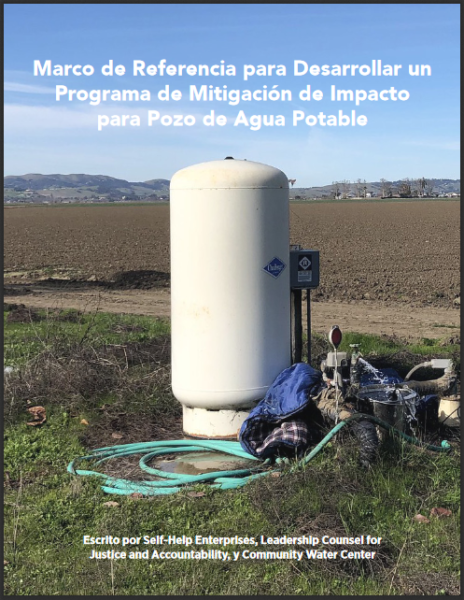 El propósito de este documento es el ser utilizado por las GSA para mitigar, prevenir y abordar cualquier efecto adverso en los pozos de agua potable causado por el volumen o la ubicación del bombeo de agua subterránea, el manejo conjunto o cualquier otra forma de manejo activo como parte de la implementación del Plan de Sostenibilidad del Agua Subterránea (GSP, por sus siglas en inglés).
El propósito de este documento es el ser utilizado por las GSA para mitigar, prevenir y abordar cualquier efecto adverso en los pozos de agua potable causado por el volumen o la ubicación del bombeo de agua subterránea, el manejo conjunto o cualquier otra forma de manejo activo como parte de la implementación del Plan de Sostenibilidad del Agua Subterránea (GSP, por sus siglas en inglés).
Al hacerlo, las GSAs pueden lograr mejor los objetivos de la Ley de Gestión Sostenible de las Aguas Subterráneas (SGMA por sus siglas en inglés), evitar poner en peligro el acceso al agua segura en comunidades vulnerables, y también evitar violar las leyes de California que establecen el Derecho Humano al Agua en todo el estado y que protegen el acceso a agua segura.
Los efectos adversos pueden incluir tanto problemas con el acceso al agua potable segura debido al aumento de la contaminación, como problemas con el acceso sostenido al agua debido a cambios en los niveles de agua subterránea.
Community Water Center’s Drinking Water Tool
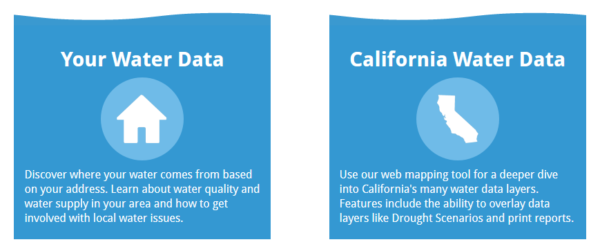 The Drinking Water Tool provides information about the ways that communities across the state might be vulnerable to groundwater challenges that could affect their access to long-term safe and affordable drinking water.
The Drinking Water Tool provides information about the ways that communities across the state might be vulnerable to groundwater challenges that could affect their access to long-term safe and affordable drinking water.
This tool tells you:
- Who manages or makes decisions about your water supply;
- Groundwater quality in the area where you live;
- Potential impacts to groundwater supply from future droughts;
- How to get involved in local groundwater management decisions.
Click here to use the tools from the Community Water Center.
Human right to water
On September 25, 2012, Governor Edmund G. Brown Jr. signed Assembly Bill (AB) 685, making California the first state in the nation to legislatively recognize the human right to water.
Water Code as Section 106.3 statutorily recognizes that “every human being has the right to safe, clean, affordable, and accessible water adequate for human consumption, cooking, and sanitary purposes.” The human right to water extends to all Californians, including disadvantaged individuals and groups and communities in rural and urban areas.
Click here to learn more at the State Water Board’s Human Right to Water portal.

